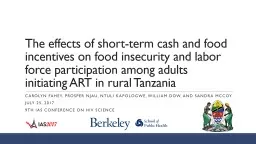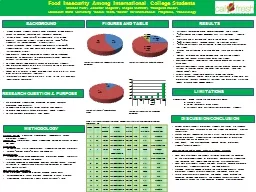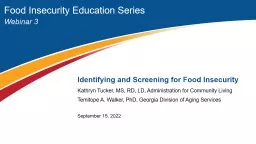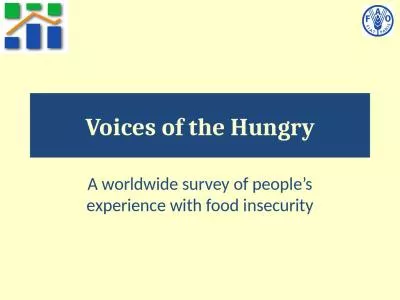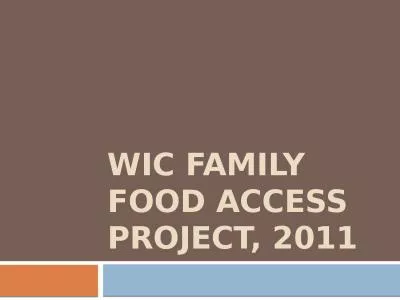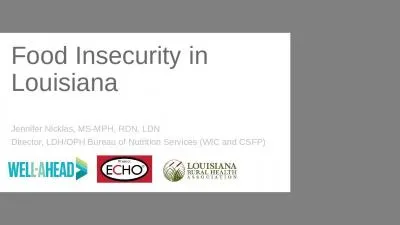PPT-The effects of short-term cash and food incentives on food insecurity and labor force
Author : liane-varnes | Published Date : 2018-02-12
adults initiating ART in rural Tanzania Carolyn Fahey Prosper Njau Ntuli Kapologwe William Dow and Sandra McCoy July 25 2017 9th IAS Conference on HIV Science
Presentation Embed Code
Download Presentation
Download Presentation The PPT/PDF document "The effects of short-term cash and food ..." is the property of its rightful owner. Permission is granted to download and print the materials on this website for personal, non-commercial use only, and to display it on your personal computer provided you do not modify the materials and that you retain all copyright notices contained in the materials. By downloading content from our website, you accept the terms of this agreement.
The effects of short-term cash and food incentives on food insecurity and labor force: Transcript
adults initiating ART in rural Tanzania Carolyn Fahey Prosper Njau Ntuli Kapologwe William Dow and Sandra McCoy July 25 2017 9th IAS Conference on HIV Science Food insecurity is a barrier to HIV care. 1.IntroductionThe total labor force participation rate of Israeli males of prime age (25–54) is low andfalling. Between 1970 and 1993 it dropped by 7.8 percentage points, from 93.5% to85.7% of th Acknowledgement: This research was funded by operating grants from the Canadian Institutes of Health Research. This presentation draws on the work of Lynn McIntyre, . Herb Emery, Naomi . Dachner. , Andy Mitchell, Rachel . John M. Kennedy. Judith A. Ouimet. Indiana University Bloomington. Why Provide Incentives. To improve survey data quality. Higher response rates. Fewer breakoffs. Fewer missing items. More precise responses. in Ohio. Rea S. . Hederman. Jr.. Executive Vice President. rea@buckeyeinstitute.org. % of People in the Labor Force out of all America residents over 16 in the private sector not in an institutional home. Sharon . Kompalla. -Porter - Rochester Institute of Technology. Chelsea Sims - Rochester Institute of Technology. Tim Miller - The George Washington University. Dana . Trimboli. - John Jay College of Criminal Justice. July 2015. Agenda. International incentive performance. South African incentive performance. IPAP . and . Incentives. The business cycle. Status of incentives. Conclusion. 2011 - 30 %. 2012 - 15 %. $15 billion. Minhee. Park. 1. , Jennifer . Maguire. 1. , Megan . Mefford. 2. , . Youngsub. . Kwon. 3. , . Humboldt State . University . 1. Social . Work, . 2. Center for International Programs, . 3. Kinesiology . The Facts. Food Insecurity : . T. he state of being without reliable access to a sufficient quantity of affordable, nutritious, food.. The Facts. Food Insecurity :. 41.2 million Americans. -28.3 million adults. Primary tool in short-term financial planning. Helps determine when the firm should experience cash surpluses and when it will need to borrow to cover working-capital costs. Allows a company to plan ahead and begin the search for financing before the money is actually needed. eCarsCash
3820 Nostrand Ave, #107B
Brooklyn, NY 11235
+1 718-393-5597 Webinar 3. Identifying and Screening for Food Insecurity. Kathryn Tucker, MS, RD, LD, Administration for Community Living. Temitope A. Walker, PhD, Georgia Division of Aging Services. September 15, 2022. Background & Motivation. FAO has the mandate to monitor progress towards the achievement of the hunger target of MDG 1 and the WFS target . Prevalence of Undernourishment (. PoU. ) as a measure of the extent of chronic food deprivation (Official MDG Ind. 1.9). Phase 2, Team A:. Financial Access and Food Insecurity. Sarah Bailey, . Juli. . Louttit. , Emily . Faerber. Outline. Basic definition of food insecurity. Determinants of food insecurity in populations and households. Director, LDH/OPH Bureau of Nutrition Services (WIC and CSFP). Food Insecurity in Louisiana. Food Insecurity in Louisiana. In 2020, it was reported that Louisiana has the . 3. rd. highest food insecurity rate .
Download Document
Here is the link to download the presentation.
"The effects of short-term cash and food incentives on food insecurity and labor force"The content belongs to its owner. You may download and print it for personal use, without modification, and keep all copyright notices. By downloading, you agree to these terms.
Related Documents

